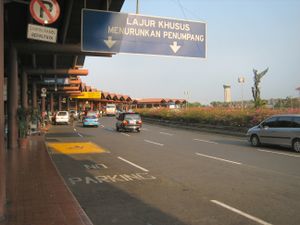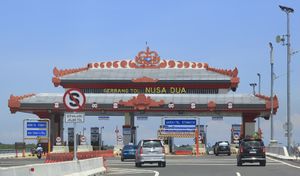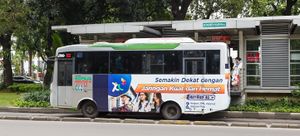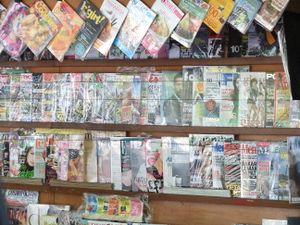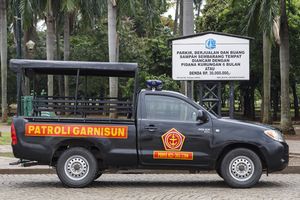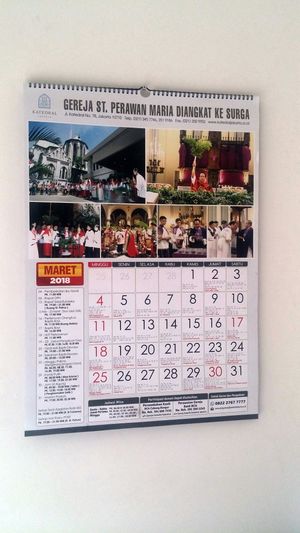اللغة الإندونيسية
| Indonesian | |
|---|---|
| bahasa Indonesia | |
| النطق | [baˈha.sa in.doˈne.sja] |
| موطنها | Indonesia |
الناطقون الأصليون | 43 million (2010 census)[1] L2 speakers: 156 million (2010 census)[1] |
| Latin (Indonesian alphabet) Indonesian Braille | |
| BISINDO, SIBI | |
| الوضع الرسمي | |
لغة رسمية في | |
لغة أقلية معترف بها في | |
| ينظمها | Badan Pengembangan dan Pembinaan Bahasa |
| أكواد اللغات | |
| ISO 639-2 | ind |
| ISO 639-2 | ind |
| ISO 639-3 | ind |
| Glottolog | indo1316 |
| Linguasphere | 31-MFA-ac |
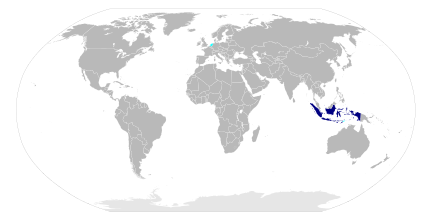 Countries of the world where Indonesian is a majority native language
Countries where Indonesian is a minority language | |
اللغة الإندونيسية (bahasa Indonesia [baˈha.sa in.doˈne.sja]) هي اللغة الرسمية لإندونيسيا. تعتبر اللغة الإندونيسية لهجة قياسية للغة الملايو اعترف بذلك رسمياً بعد إعلان الاستقلال الإندونيسي في عام 1945، واللغتان تبقيان متشابهتان بشكل كبير.
عدد المتحدثين باللغة الإندونيسية كلغة أم هو 17 إلى 30 مليون. يستخدم اللغة الإندونيسية سكان إندونيسيا الذي يعتبرونها لغة ثانية بعد لغاتهم الأم المحلية (كاللغة الجاوية واللغة المينانغكاباوية)، ولكن اللغة التي يستخدمها أغلب الجهات الرسمية والتعليمية والإعلام في إندونيسيا هي اللغة الإندونيسية. الاسم المحلي للغة الإندونيسية هو "باهاسا إندونيسيا" (Bahasa Indonesia) بمعنى "لغة إندونيسيا". الاسم "باهاسا" بحد ذاته لا يعني اللغة الإندونيسية بل يعني "لغة". في حين اللغة الإندونيسية اللغة الرسمية لإندونيسيا، تستخدم اللغة أيضاً في تيمور الشرقية. تستخدم اللغة الإندونيسية الأبجدية اللاتينية في الكتابة.
. . . . . . . . . . . . . . . . . . . . . . . . . . . . . . . . . . . . . . . . . . . . . . . . . . . . . . . . . . . . . . . . . . . . . . . . . . . . . . . . . . . . . . . . . . . . . . . . . . . . . . . . . . . . . . . . . . . . . . . . . . . . . . . . . . . . . . . . . . . . . . . . . . . . . . . . . . . . . . . . . . . . . . . .
التاريخ
عصر الممالك المبكرة
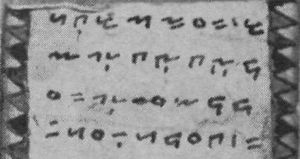
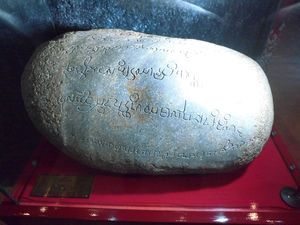
الملايو القديمة كـlingua franca
عصر الاستعمار الهولندي
مولد اللغة الإندونيسية

اتخاذها لغة وطنية
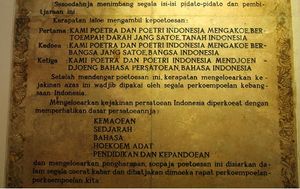
الإندونيسية الحديثة والدارجة
التبويب واللغات ذات الصلة
Indonesian is one of the many varieties of Malay. Malay historical linguists agree on the likelihood of the Malay homeland being in western Borneo stretching to the Bruneian coast.[3] A form known as Proto-Malay language was spoken in Borneo at least by 1000 BCE and was, it has been argued, the ancestral language of all subsequent Malayan languages. Its ancestor, Proto-Malayo-Polynesian, a descendant of the Proto-Austronesian language, began to break up by at least 2000 BCE, possibly as a result of the southward expansion of Austronesian peoples into Maritime Southeast Asia from the island of Taiwan.[4] Indonesian, which originated from Malay, is a member of the Austronesian family of languages, which includes languages from Southeast Asia and the Pacific Ocean, with a smaller number in continental Asia. It has very high mutual intelligibility with the Malay register in Malaysia, which is officially known there as Bahasa Malaysia. The similarities are comparable to those between British English and American English.
Malagasy, a geographic outlier spoken in Madagascar in the Indian Ocean; the Philippines national language, Filipino; and the native language of New Zealanders, Māori language are also members of this language family. Although each language of the family is mutually unintelligible, their similarities are rather striking. Many roots have come virtually unchanged from their common ancestor, Proto-Austronesian language. There are many cognates found in the languages' words for kinship, health, body parts and common animals. Numbers, especially, show remarkable similarities.
| اللغة | 1 | 2 | 3 | 4 | 5 | 6 | 7 | 8 | 9 | 10 |
|---|---|---|---|---|---|---|---|---|---|---|
| PAN, ح. 4000 BCE | *isa | *DuSa | *telu | *Sepat | *lima | *enem | *pitu | *walu | *Siwa | *puluq |
| Amis | cecay | tusa | tulu | sepat | lima | enem | pitu | falu | siwa | pulu' |
| Rukai | itha | drusa | tulru | supate | lrima | eneme | pitu | valru | bangate | pulruku |
| Tsou | coni | yuso | tuyu | sʉptʉ | eimo | nomʉ | pitu | voyu | sio | maskʉ |
| Tagalog | isá | dalawá | tatló | ápat | limá | ánim | pitó | waló | siyám | sampu |
| Ilocano | maysá | dua | talló | uppát | limá | inném | pitó | waló | siam | sangapúlo |
| Cebuano | usá | duhá | tuló | upat | limá | unom | pitó | waló | siyám | napulu |
| Chamorro | maisa/håcha | hugua | tulu | fatfat | lima | gunum | fiti | guålu | sigua | månot/fulu |
| Malagasy | iray | roa | telo | efatra | dimy | enina | fito | valo | sivy | folo |
| Batak | sada | dua | tolu | opat | lima | onom | pitu | walu | sia | sapuluh |
| Malay/Indonesian | satu | dua | tiga | empat | lima | enam | tujuh | lapan/delapan | sembilan | sepuluh |
| Minangkabau | ciek | duo | tigo | ampek | limo | anam | tujuah | salapan | sambilan | sapuluah |
| Rejang[5] | do | duai | tlau | pat | lêmo | num | tujuak | dêlapên | sêmbilan | sêpuluak |
| Javanese | siji | loro | telu | papat | lima | nem | pitu | wolu | sanga | sepuluh |
| Tetun | ida | rua | tolu | hat | lima | nen | hitu | ualu | sia | sanulu |
| Fijian | dua | rua | tolu | vā | lima | ono | vitu | walu | ciwa | tini |
| Kiribati | teuana | uoua | teniua | aua | nimaua | onoua | itiua | waniua | ruaiua | tebuina |
| Tongan | taha | ua | tolu | fā | nima | ono | fitu | valu | hiva | -fulu |
| Sāmoan | tasi | lua | tolu | fā | lima | ono | fitu | valu | iva | sefulu |
| Māori | tahi | rua | toru | whā | rima | ono | whitu | waru | iwa | tekau (archaic: ngahuru) |
| Tahitian | hō'ē | piti | toru | maha | pae | ōno | hitu | va'u | iva | 'ahuru |
| Marquesan | tahi | 'ua | to'u | hā | 'ima | ono | hitu | va'u | iva | 'ahu'u |
| Leeward Islands (Society Islands) language | tahi | rua | toru | fā | rima | ono | fitu | varu | iva | 'ahuru |
| Hawaiian | kahi | lua | kolu | hā | lima | ono | hiku | walu | iwa | -'umi |
. . . . . . . . . . . . . . . . . . . . . . . . . . . . . . . . . . . . . . . . . . . . . . . . . . . . . . . . . . . . . . . . . . . . . . . . . . . . . . . . . . . . . . . . . . . . . . . . . . . . . . . . . . . . . . . . . . . . . . . . . . . . . . . . . . . . . . . . . . . . . . . . . . . . . . . . . . . . . . . . . . . . . . . .
Official status
Phonology
Vowels
It is usually said that there are six vowels in Indonesian.[6] These six vowels are shown in the table below. However, other analyses set up a system with other vowels, particularly the open-mid vowels /ɛ/ and /ɔ/.[7]
| Front | Central | Back | |
|---|---|---|---|
| Close | i | u | |
| Close-mid | e | ə | o |
| Open-mid | (ɛ) | (ɔ) | |
| Open | a |
In standard Indonesian orthography, the Latin alphabet is used, and five vowels are distinguished: a, i, u, e, o. In materials for learners, the mid-front vowel /e/ is sometimes represented with a diacritic as é to distinguish it from the mid-central vowel /ə/.
Diphthongs
Indonesian has four native diphthong phonemes only in open syllables[8], they are:
- /ai̯/: kedai ('shop'), pandai ('clever')
- /au̯/: kerbau ('buffalo'), limau ('lemon')
- /oi̯/ (or /ʊi̯/ in Indonesian): dodoi, amboi
- /ei̯/: survei ('survey')
Some analyses assume that these diphthongs are actually a monophthong followed by an approximant, so ⟨ai⟩ represents /aj/, ⟨au⟩ represents /aw/, and ⟨oi⟩ represents /oj/. On this basis, there are no phonological diphthongs in Indonesian.[9]
Diphthongs are differentiated from two vowels in two syllables, such as:
- /a.i/: e.g. lain ('other') [la.in], air ('water') [a.ir]
- /a.u/: bau ('smell') [ba.u], laut ('sea') [la.ut]
Consonants
| Labial | Alveolar | Palatal | Velar | Glottal | ||
|---|---|---|---|---|---|---|
| Nasal | m | n | ɲ | ŋ | ||
| Plosive/Affricate | voiceless | p | t | t͡ʃ | k | (ʔ) |
| voiced | b | d | d͡ʒ | ɡ | ||
| Fricative | voiceless | (f) | s | (ʃ) | (x) | h |
| voiced | (v) | (z) | ||||
| Approximant | w | l | j | |||
| Trill | r | |||||
. . . . . . . . . . . . . . . . . . . . . . . . . . . . . . . . . . . . . . . . . . . . . . . . . . . . . . . . . . . . . . . . . . . . . . . . . . . . . . . . . . . . . . . . . . . . . . . . . . . . . . . . . . . . . . . . . . . . . . . . . . . . . . . . . . . . . . . . . . . . . . . . . . . . . . . . . . . . . . . . . . . . . . . .
عبارات أساسية
| العبارة | الترجمة |
|---|---|
| bahasa Indonesia | اللغة الإندونيسية |
| halo | مرحباً |
| selamat pagi | صباح الخير |
| selamat sore | مساء الخير |
| selamat tinggal | وداعاً |
| tolong | رجاءً |
| terima kasih | شكراً |
| terima kasih kembali | لا شكر على واجب |
| ini | هذا |
| itu | ذلك |
| berapa؟ | بكم؟ |
| ya | نعم |
| tidak | لا |
| maaf | آسف |
| saya tidak mengerti | لا أفهم |
| saya tidak tahu | لا أعلم |
| saya tidak bisa berbicara bahasa Indonesia | لا أتحدث اللغة الإندونيسية |
| di mana toilet? | أين الحمام؟ |
Words
Numbers

Cardinal
| Number | English | Indonesian |
|---|---|---|
| 0 | zero | nol or kosong [nol] or [ko•soŋ] |
| 1 | one | satu [sa•tu] |
| 2 | two | dua [du•(w)a] |
| 3 | three | tiga [ti•ga] |
| 4 | four | empat [əm•pat] |
| 5 | five | lima [li•ma] |
| 6 | six | enam [ə•nam] |
| 7 | seven | tujuh [tu•dʒuh] |
| 8 | eight | delapan [də•la•pan] |
| 9 | nine | sembilan [səm•bi•lan] |
| 10 | ten | sepuluh [sə•pu•luh] |
| 11 | eleven | sebelas [sə•bə•las] |
| 12 | twelve | dua belas [du•(w)a bə•las] |
| 13 | thirteen | tiga belas [ti•ga bə•las] |
| 14 | fourteen | empat belas [əm•pat bə•las] |
| 15 | fifteen | lima belas [li•ma bə•las] |
| 20 | twenty | dua puluh [du•(w)a pu•luh] |
| 21 | twenty one | dua puluh satu [du•(w)a pu•luh sa•tu] |
| 30 | thirty | tiga puluh [ti•ga pu•luh] |
| 100 | one hundred | seratus [sə•ra•tus] |
| 200 | two hundred | dua ratus [du•(w)a ra•tus] |
| 210 | two hundred ten | dua ratus sepuluh [du•(w)a ra•tus sə•pu•luh] |
| 897 | eight hundred ninty seven | delapan ratus sembilan puluh tujuh [de•la•pan ra•tus sem•bi•lan pu•luh tu•dʒuh] |
| 1000 | one thousand | seribu [sə•ri•bu] |
| 10000 | ten thousand | sepuluh ribu [sə•pu•luh ri•bu] |
| 100000 | one hundred thousand | seratus ribu [sə•ra•tus ri•bu] |
| 1000000 | one million | sejuta or satu juta [sə•dʒu•ta] or [sa•tu dʒu•ta] |
| 1000000000 | one billion | satu miliar [sa•tu mi•li•(j)ar] or [sa•tu mil•jar] |
| 1000000000000 | one trillion | satu triliun [sa•tu tri•li•(j)un] or [sa•tu tril•jun] |
Ordinal
| Number | English | Indonesian |
|---|---|---|
| 1st | first | pertama [pər•ta•ma] |
| 2nd | second | kedua [kə•du•(w)a] |
| 3rd | third | ketiga [kə•ti•ga] |
| 4th | fourth | keempat [kə•əm•pat] |
| 5th | fifth | kelima [kə•li•ma] |
| 6th | sixth | keenam [kə•ə•nam] |
| 7th | seventh | ketujuh [kə•tu•dʒuh] |
| 8th | eighth | kedelapan [kə•də•la•pan] |
| 9th | ninth | kesembilan [kə•səm•bi•lan] |
| 10th | tenth | kesepuluh [kə•sə•pu•luh] |
Days and months
Days
| English | Indonesian |
|---|---|
| Monday | Senin [sə•nin] |
| Tuesday | Selasa [sə•la•sa] |
| Wednesday | Rabu [ra•bu] |
| Thursday | Kamis [ka•mis] |
| Friday | Jumat [dʒum•at] |
| Saturday | Sabtu [sab•tu] |
| Sunday | Minggu/Ahad [miŋ•gu] or [a•had] |
Months
| English | Indonesian |
|---|---|
| January | Januari [dʒa•nu•(w)a•ri] |
| February | Februari [fɛb•ru•(w)a•ri] |
| March | Maret [ma•rət] |
| April | April [ap•ril] |
| May | Mei [meɪ] |
| June | Juni [dʒu•ni•] |
| July | Juli [dʒu•li] |
| August | Agustus [a•gus•tus] |
| September | September [sɛp•tɛm•bər] |
| October | Oktober [ok•to•bər] |
| November | November [no•vɛm•bər] |
| December | Desember [dɛ•sɛm•bər] |
Common phrases
| English | Indonesian | Spelling (in IPA) |
|---|---|---|
| Hello! | Halo! | [ˈhalo] |
| Good morning! | Selamat pagi! | [sə'lamat ˈpagi] |
| Good afternoon! | Selamat siang! | [səˈlamat ˈsiaŋ] |
| Good evening! or Good night! | Selamat malam! | [səˈlamat ˈmalam] |
| Goodbye! | Selamat tinggal! | [sə'lamat ˈtiŋɡal] |
| See you later! | Sampai jumpa lagi! | [ˈsampai̯ ˈdʒumpa ˈlagi] |
| Thank you | Terima kasih (standard, formal) | [təˈrima ˈkasih] |
| Thanks | Makasih (colloquial) | [maˈkasih] |
| You are welcome | Sama-sama or terima kasih kembali | [ˈsa'ma ˈsama] or [təˈrima ˈkasih kəm'bali] |
| Yes | Ya or iya | [ˈja] or [ˈija] |
| No | Tidak | [ˈtidaʔ] |
| And | Dan | [ˈdan] |
| Or | Atau | [a'tau̯] |
| Because | Karena | [ˈkarəna] |
| Therefore [ك] | Karena itu | [ˈkarəna ˈʔitu] |
| Nothing | Tidak ada | [ˈtidaʔ ˈada] |
| Maybe | Mungkin | [ˈmuŋkin] |
| How are you? | Apa kabar? | [ˈapa ˈkabar] |
| I am fine | Baik or Baik-baik saja | [ˈbaik] or [ˈbaik ˈbaik ˈsadʒa] |
| Have a nice day! | Semoga hari Anda menyenangkan! | [sə'moga ˈhari ˈʔanda məɲəˈnaŋkan] |
| Bon appétit! | Selamat makan! or Selamat menikmati! | [sə'lamat ˈmakan] or [səˈlamat mənikˈmati] |
| I am sorry | Maafkan saya | [ma'ʔafkan ˈsaja] |
| Excuse me | Permisi | [pər'misi] |
| What? | Apa? | [ˈapa] |
| Who? | Siapa? | [siˈapa] |
| When? | Kapan? | [ˈkapan] |
| Where? | Di mana? | [di ˈmana] |
| Why? | Mengapa? | [mə'ŋapa] |
| How? | Bagaimana? | [baɡai̯'mana] |
| How much? | Berapa? | [bə'rapa] |
| What is your name? | Nama Anda siapa? | [ˈnama ˈʔanda siˈapa] |
| My name is... | Nama saya... | [ˈnama ˈsaja] |
| Do you know? | Apakah Anda tahu? | [aˈpakah ˈʔanda ˈtahu] |
| Yes, I know / No, I do not know | Ya, saya tahu / Tidak, saya tidak tahu | [ˈja ˈsaja ˈtahu] / [ˈtidaʔ ˈsaja ˈtidaʔ ˈtahu] |
| Can you speak Indonesian? | Bisakah Anda berbicara bahasa Indonesia? | [biˈsakah ˈʔanda bərbi'tʃara baˈhasa indoˈnesi̯a] |
| Yes, I can speak Indonesian / No, I can not speak Indonesian | Ya, saya bisa berbicara bahasa Indonesia / Tidak, saya tidak bisa berbicara bahasa indonesia | [ˈja ˈsaja ˈbisa bərbiˈtʃara baˈhasa Indoˈnesi̯a] / [ˈtidaʔ ˈsaja ˈtidaʔ ˈbisa bərbiˈtʃara baˈhasa indoˈnesi̯a] |
| What time is it now? | Pukul berapa sekarang? | [ˈpukul bə'rapa səˈkaraŋ] |
| It is 5.00 o'clock | Sekarang pukul 5.00 | [səˈkaraŋ ˈpukul ˈlima] |
| When will you go to the party? | Kapan Anda akan pergi ke pesta itu? | [ˈkapan ˈʔanda ˈʔakan pər'gi ke ˈpesta ˈʔitu] |
| Soon | Nanti | [ˈnanti] |
| Today | Hari ini | [ˈhari ˈʔini] |
| Tomorrow | Besok | [ˈbesok] |
| The day after tomorrow | Lusa | [ˈlusa] |
| Yesterday | Kemarin | [kə'marin] |
| Congratulations! | Selamat! | [sə'lamat] |
| Happy New Year! | Selamat Tahun Baru! | [sə'lamat ˈtahun ˈbaru] |
| Merry Christmas! | Selamat Natal! | [sə'lamat ˈnatal] |
| Please | Mohon or tolong | [ˈmohon] or [ˈtoloŋ] |
| Stop! | Berhenti! | [bər'henti] |
| I am happy | Saya senang | [ˈsaja sə'naŋ] |
| I understand | Saya mengerti | [ˈsaja ˈməŋərti] |
| Help! | Tolong! | [ˈtoloŋ] |
| I need help | Saya memerlukan bantuan | [ˈsaja məmərˈlukan ban'tuan] |
| Can you help me? | Bisakah Anda menolong saya? | [biˈsakah ˈʔanda mə'noloŋ ˈsaja] |
| Can I help you? / Do you need help? | Dapatkah saya membantu Anda? / Apakah Anda membutuhkan bantuan? | [da'patkah ˈsaja məm'bantu ˈʔanda] / [aˈpakah ˈʔanda məmbuˈtuhkan banˈtuan] |
| May I borrow your eraser? | Bolehkah saya meminjam penghapus Anda? | [boˈlehkah ˈsaja mə'minjam peŋ'hapus ˈʔanda] |
| With my pleasure | Dengan senang hati | [dəˈŋan sə'naŋ ˈhati] |
| Welcome | Selamat datang | [sə'lamat ˈdataŋ] |
| Welcome to Indonesia | Selamat datang di Indonesia | [sə'lamat ˈdataŋ di ʔindoˈnesi̯a] |
| I agree / I disagree | Saya setuju / Saya tidak setuju | [ˈsaja sə'tudʒu] / [ˈsaja ˈtidaʔ sə'tudʒu] |
| I understand / I do not understand | Saya mengerti / Saya tidak mengerti | [ˈsaja ˈməŋərti] / [ˈsaja ˈtidaʔ ˈməŋərti] |
| I am hungry | Saya lapar | [ˈsaja ˈlapar] |
| I am thirsty | Saya haus | [ˈsaja ˈhaus] |
| I am sick | Saya sakit | [ˈsaja ˈsakit] |
| Get well soon | Semoga cepat sembuh | [sə'moga tʃə'pat səmˈbuh] |
Example
The following texts are excerpts from the official translations of the Universal Declaration of Human Rights in Indonesian and Malay, along with the original declaration in English.
| English[10] | Indonesian[11] | Malay[12] |
|---|---|---|
| Universal Declaration of Human Rights | Pernyataan Umum tentang Hak Asasi Manusia | Perisytiharan Hak Asasi Manusia sejagat |
| Article 1 | Pasal 1 | Perkara 1 |
| All human beings are born free and equal in dignity and rights. They are endowed with reason and conscience and should act towards one another in a spirit of brotherhood. | Semua orang dilahirkan merdeka dan mempunyai martabat dan hak-hak yang sama. Mereka dikaruniai akal dan hati nurani dan hendaknya bergaul satu sama lain dalam semangat persaudaraan. | Semua manusia dilahirkan bebas dan sama rata dari segi maruah dan hak-hak. Mereka mempunyai pemikiran dan perasaan hati dan hendaklah bergaul dengan semangat persaudaraan. |
See also
- Austronesian languages
- Bahasa, for other languages referred to as bahasa
- Language families and languages
- Malay language
- Demographics of Indonesia
- Indonesian slang language
- Indonesian abbreviated words
- Comparison of Standard Malay and Indonesian
- List of English words of Indonesian origin
- List of loanwords in Indonesian
References
- ^ أ ب خطأ استشهاد: وسم
<ref>غير صحيح؛ لا نص تم توفيره للمراجع المسماةsensus2010 - ^ "East Timor Languages". www.easttimorgovernment.com. Archived from the original on 4 مارس 2016. Retrieved 21 مارس 2016.
- ^ Adelaar, K. Alexander (2004). "Where does Malay come from? Twenty years of discussions about homeland, migrations and classifications" (PDF). Bijdragen tot de Taal-, Land- en Volkenkunde. 160 (1): 1–30. doi:10.1163/22134379-90003733. hdl:11343/122869. JSTOR 27868100.
- ^ Andaya, Leonard Y. (2001), "The Search for the 'Origins' of Melayu", Journal of Southeast Asian Studies 32 (3): 315–330, doi:, http://sabrizain.org/malaya/library/search.pdf, retrieved on 13 October 2019
- ^ Munir Hamidy, Badrul (1985). Kamus Lengkap Indonesia-Rejang, Rejang-Indonesia. Pusat Pembinaan dan Pengembangan Bahasa, Departemen Pendidikan dan Kebudayaan. p. xv.
- ^ خطأ استشهاد: وسم
<ref>غير صحيح؛ لا نص تم توفيره للمراجع المسماةSodOlson2008 - ^ Yunus Maris, M. (1980). The Indonesian Sound System. Kuala Lumpur: Penerbit Fajar Bakti Sdn. Bhd, page 2.
- ^ Minister of Education and Culture Decree No: 50/2015, Jakarta, 2015.
- ^ Clynes, A (1997). "On the Proto-Austronesian 'diphthongs'". Oceanic Linguistics. 36 (2): 347–362. doi:10.2307/3622989. JSTOR 3622989.
- ^ "OHCHR -". www.ohchr.org. Archived from the original on 30 أغسطس 2016. Retrieved 16 أغسطس 2016.
- ^ "OHCHR -". www.ohchr.org. Archived from the original on 21 سبتمبر 2016. Retrieved 16 أغسطس 2016.
- ^ "OHCHR -". www.ohchr.org. Archived from the original on 21 سبتمبر 2016. Retrieved 16 أغسطس 2016.
External links
- How many people speak Indonesian?
- free language resource
- Learning Indonesian
- Indonesian Swadesh list of basic vocabulary words (from Wiktionary's Swadesh-list appendix)
- Indonesia WWW Virtual Library
- Bahasa Indonesia Dictionary
- Kamus Besar Bahasa Indonesia dalam jaringan (Great Dictionary of the Indonesian Language of the Language Center, in Indonesian only)
- Example recording of spoken Indonesian
- Informasi Bahasa Indonesia
- Tv Online
- Indonesia Language
- babla.co.id English-Indonesian dictionary from bab.la, a language learning portal
English-Indonesian translation services
- Google Indonesia Translator
- http://www.indotranslate.com/translated-text.php
- http://vvv.sederet.com/translate.php
- http://translation2.paralink.com/English-Indonesian-Translator
- http://imtranslator.net/translation/english/to-indonesian/translation/
English-Indonesian dictionaries
- http://www.softpedia.com/get/Others/Home-Education/Kamus.shtml
- http://indodic.com/dlEnglish.html http://indodic.com/dlIndo.html
قالب:Languages of East Timor قالب:Languages of Taiwan قالب:Austronesian languages
- Short description is different from Wikidata
- Use dmy dates from March 2019
- Articles containing إندونيسية-language text
- Languages with ISO 639-2 code
- Languages with ISO 639-1 code
- ISO language articles citing sources other than Ethnologue
- Articles with hatnote templates targeting a nonexistent page
- Articles containing ملايو (لغة كبرى)-language text
- Indonesian language
- لغات إلصاقية
- Malayan languages
- Languages of Indonesia
- Languages of East Timor
- Standard languages
- Subject–verb–object languages
- لغات إندونسيا
- لغات أوسترونيزية

